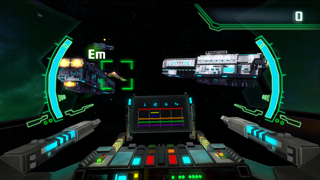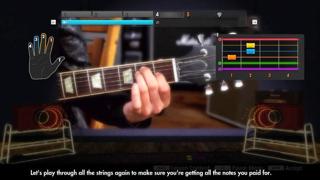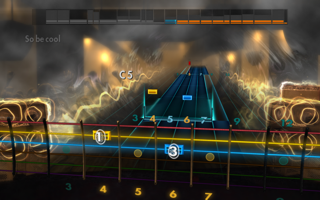How I Didn't Learn Guitar by Playing Rocksmith 2014

Some time later, I thought of taking up the axe again, rescuing my dusty guitar from where she was languishing in the corner of my bedroom. I got another nudge in this direction when a musically-inclined woman on OkCupid called me out on my profile photo where I’m holding a guitar. (“Can you actually play, or is that just to impress the ladies?” “It’s to impress the ladies. Is it working?") Then Rocksmith 2014 went on sale and I read a glowing review of it, and I took the plunge.
(Incidentally, this is the first game I’ve ever played where I thought, “Man, I actually wish I were playing this with a Kinect.” It’s obnoxious to have to take your hands off the guitar and grab a controller to do basically anything. It would be amazing to be able to just say “Riff repeater, 50% speed!” and have it drop into the riff repeater at 50% speed.)
The game advises you to play for an hour every day, which I tried hard to stick to. Daily play was easy enough to achieve, but I didn’t always manage to last a full hour. At first, it was because I felt like I was learning a lot very quickly, and needed to take a break to digest. But after a few days, it was because I was getting frustrated.
I hit a bit of a wall, and the wall was called “chords”. Chords are hard, and the game didn’t seem to acknowledge this, which made me wonder if I was just an idiot who didn’t have what it takes to learn the guitar and I should slink off back to the keyboard. (I acknowledge that I may be biased by the fact that I took piano lessons from age five to twelve, but the keyboard is WAY more usable of an instrument. You don’t have to memorize weird hand positions in order to play chords. You just put your fingers on the keys. But the guitar is just so much sexier.)
After going into a ton of detail about how to hold the pick, how to identify frets, how to strum, etc., Rocksmith just kind of throws chords at you as if they’re not an order of magnitude harder than single notes. “Here, play this chord,” the game says. “Whoa, hold on a sec!” I say. “Let me figure out which fingers to put on which strings at which frets, and how to contort my hand so that I don’t accidentally mute the other strings with my palm.” By then I have missed the chord, and the game says, “Okay, now play this other chord!”
Being able to quickly figure out and play chords rapidly became the biggest barrier to my progress, so I reasoned that what I needed was chord drills. I wanted the game to give me a series of chords to try to play as quickly as I could, over and over. The good news is that this is a feature the game has - the bad news is that they screwed it up pretty badly.

The problem is that if you take too long to shoot down the enemy, it shoots you, and you can only take so many hits before game over. I’m going to say that again - this is a tool to help you practice fundamental guitar skills and YOU CAN GET A GAME OVER. Every time I played, I’d eventually get a new chord I hadn’t played much and I’d have to look down and figure out how to arrange my fingers. By the time I was ready to strum the chord, I didn’t even get to find out if the game thought I did it right. Instead I had to wait while my ship blew up, sit through being told what my score was, and get kicked back to the menu where I could start a new session and be given a totally different chord.
I have written at some length about punishment being problematic in skill-based games, due to the way it interferes with learning. Having it show up here in a ‘game’ that is actually a learning tool really throws it into sharp relief, in a way that I would find fascinating were I not so busy finding it utterly infuriating. I have actually shouted “I am trying to learn!” at my TV when game-overing at Star Chords. When I went online looking for a way to turn on some kind of no-fail practice mode, all I found were forum threads where folks requested this capability, which apparently doesn’t exist - for any of the guitarcade games. It would have been so easy for Rocksmith to give me what I needed here, but when making the guitarcade games they forgot that this is primarily a teaching tool, and so they created something that is nearly useless to me.
I knew my progress would be glacial until I got better at chords, and Rocksmith did not give me the tools to do that effectively. I considered setting up some kind of chord drills outside the context of the game, which would of course lack the game’s feedback on whether I’d played the chord successfully - which would put me right back where I was before I bought the game in the first place.
So I tried switching it from rhythm guitar to lead guitar, because that has fewer chords. Instead I found myself working on hammer-ons and pull-offs. To try to pick these up, I went into Rocksmith’s “Lesson” mode. These are videos that demonstrate a technique coupled with a brief section where you do the technique a couple of times. They way they’re packaged, they feel like quick introductions so that you basically know how to do a thing, and then you go practice that thing in songs or guitarcade games or what-have-you.

The result was that I felt like the game expected me to be able to do this in a few minutes and move on to bigger and better things. And I just couldn’t do that. In a game that is touted for being noob-friendly and the fastest way to learn guitar, this was frustrating. It was increasingly difficult to believe that the game simply suffered from design flaws and that I wasn’t actually constitutionally incapable of playing the guitar. I found myself dreading practice sessions and asking myself why I wanted to bother in the first place.
Because here’s the thing - whenever I played Rocksmith, I was keenly aware that there were other things I could do with my time. I could write something. I could work on a website. I could go for a jog. I could call up a friend and go be social. As much as I didn’t want to just give up on something because I wasn’t awesome at it right away, if my rate of learning was actually really low then at some point the cost/benefit analysis says it’s not worth the trouble.
I was playing the game over a few weeks vacation from work, and I knew that time was a sort of make-it-or-break-it probationary period for the game. My job keeps me plenty busy - for it to be worth continuing practicing the guitar once the break was over, I was going to have to make enough progress beforehand that the process was intrinsically rewarding, and would be at least a halfway decent way to unwind after a day at the office. So far, that wasn’t happening from guitarcade or the lessons, so I turned fully to the game’s main mode, Learn A Song. If I couldn’t drill on the specific skills I needed to improve, I could at least just practice a song repeatedly, gradually mastering it. But here I ran into trouble too.

Rocksmith’s dynamic difficulty means you’re chasing goalposts that are always moving, up until the point where you can play the song perfectly every time. Until you put the hours and hours into proving you know the song, it’s going to make the parts you struggle with easier and the parts you are proficient in harder. It never feels like you’re getting anywhere, and this turns the game into a treadmill where it’s impossible to find a good pace.
To me, it felt like being taught guitar by a reluctant older brother who’s annoyed at your progress. Whenever it sounds like you’re about to be able to consistently handle the current challenge, he says, “Okay, how about this?" and throws you off balance again. There was never the satisfaction of actually getting the hang of something that’s been giving you trouble. That meant no intrinsic reward. And that meant that it would be incredibly hard to force myself to keep at it while working full time. And I knew I’d rather spend the willpower on something else. So I abandoned the game.
Added March 18, 2017: Based on some comments this post has received, I want to clarify something that may not have been explicit before.
My critique is not that learning guitar is hard. My critique is that Rocksmith is a bad teacher. How easy a skill is to master is a different axis from the effectiveness of a learning method.
I’ve always known that playing guitar is hard. Most things worth doing are hard. I’ve always known that to learn guitar, I’d have to put in a lot of time and effort - regardless of whether I taught myself, got lessons from a human, or used an electronic tutor.
I didn’t give up on Rocksmith because learning guitar is hard. That’s actually why I bought Rocksmith in the first place. I was looking for a good teacher, not to eliminate the need for time and effort but to maximize the return on that time and effort. I gave up on Rocksmith because it’s a bad teacher. And I wrote about its failings as a teacher because they are wholly fixable game design decisions.
Added September 2, 2020: A number of commenters have explained how they supplemented or worked around Rocksmith’s limitations to create a complete and successful learning experience. If you’re looking for guidance on how to get the most out of Rocksmith, I recommend perusing the comments - everyone learns differently, but you may find a setup that works for you.
I remain frustrated that these supplements and workarounds are necessary, as I believe that with some different design decisions the game could have been better enough not to need them. But it’s clear that if you understand its flaws and how to deal with them, Rocksmith can still be a valuable educational tool.